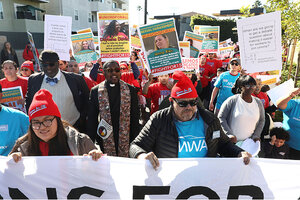US low-income workers gain ground. Finally.

Community and union members join cooks and cashiers on a picket line outside a McDonald's restaurant, demanding higher wages and union rights in the world's second-largest private-sector company, in Los Angeles Dec. 19, 2019.
Patrick T. Fallon/Reuters
Washington
A new year has arrived with pay raises in store for many of the lowest-income U.S. workers. Wages have actually been growing faster for the bottom quarter of U.S. earners than for other income groups – a positive sign in an economy that has been defined in recent decades by widening inequality.
A worker shortage has forced many employers to raise pay. Our chart package below shows the progress, and it illustrates another key reason: Many state laws will see scheduled increases to minimum wage this year, or annually adjust that wage for inflation. The changes for 2020 span from Alaska to Florida. In some states, minimum pay has a range that depends on the employer size, geography, type of work, or (in Nevada’s case) whether a job comes with health insurance.
Some economists warn of mixed effects when wage levels are mandated. It can be an incentive for companies to substitute automation for employment. But many experts on the issue say that, on balance, the effects of boosts in minimum wages across America have been positive for workers.
Why We Wrote This
A counter trend to rising inequality: Low-wage workers are seeing bigger raises than high-wage earners.
“These real minimum wage increases since 2010 have not only raised low-wage workers’ wages generally,” analysts at the left-leaning Economic Policy Institute said in a Labor Day report last year. They “have also played an important role in reducing the gender pay gap at the bottom of the wage distribution.”
